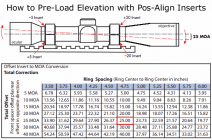The original Signature Z ring inserts were specified in thousandths and based on that I was able to do a simple ratio problem to come up with the effect at a given distance with a given spacing. For visualization, I suggest that people think of the rifle scope as mounted on a fixture where the scope is held so that its cross hairs are on target and depending on which way you want the bullet hole to go, you will be tilting the bore more up or down. When I was working with insert offsets in thousandths of an inch, for the math, I would convert the distance to target into inches. My standard method was to center the scope reticle on the OD of the main tube, by rotating the scope in a padded, home made V block fixture, rotating and adjusting until the cross hair intersection did not move on a target as the scope was rotated, then I would mount the scope with the zero insert rings, and shoot a couple of shots at a target at say 50 yards, and measure the horizontal and vertical distance (in inches) of the group or bullet hole from the point of aim. With that information and the center to center ring spacing, I was good to go for the math. The whole calculation took less time than writing this.











